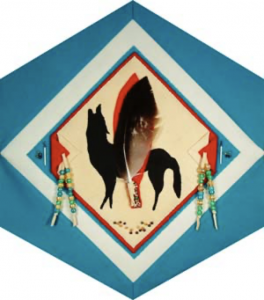Okanagan

The Block
Colleen Baptiste created the block to represent the Okanagan people at the request of Okanagan Chief Clarence Louie. Although skilled at quilting and beadwork, Colleen decided on paint as the main medium for this project. Working on a buckskin canvas she painted an image of the all-knowing coyote, symbolic of the people’s legends. Coyote was the one, sent by Old Man, who showed the people where to find the most abundant fishing spots. He taught them to share with each other, care for the environment and to use their skills for the benefit of the community. These values are still very much a part of Okanagan culture.
Cultural Profile
The Okanagan Valley, along the Columbia plateau in Southern British Columbia, is the traditional territory of the Okanagan First Nations people, the Syeelhwh Nation, which means “the people who live here”. They are an Interior Salish people, known as the syilx-speaking people. The indigenous name for Okanagan is S’Ookanhkchinx meaning “transport toward the head or top end”. The term speaks of the transportation routes from the head of Okanagan Lake, to where the Okanagan and Columbia rivers meet. The Okanagan people travelled these waters, in a semi-nomadic existence, to hunt deer and small game animals, fish for salmon, and gather roots, berries and medicinal plants.
Coyote taught the Okanagan how to work in harmony with the laws of nature in order to survive. Their recorded history, cepcaptikwl, is related through the meanings in stories told by the elders. Their communities were represented by a chief groomed and trained for the position by the previous chief. It was the responsibility of the chief to protect his people and their land, maintaining a balance between the two. By doing this he also sustained a healthy natural environment for future generations.
The Okanagan most likely had their first encounter with Europeans late in the 1700’s, in the form of Hudson’s Bay traders. Eventually, the Hudson’s Bay Company set up their “brigade trail” right through Okanagan territory to link Fort Kamloops to Fort Colville in Washington, U.S.A. This first contact was the beginning of a gradual influx of settlers into the region. Until Confederation, when Native peoples were designated reserves, the Okanagan continued their traditional lifestyle.
The Okanagan Nation today includes seven communities. Like their ancestors they are creative thinkers, artists, musicians and storytellers, who believe the values of sharing caring and respect for others and the land sent by Old Man and taught by Coyote.
Sponsor: Sunshine Women’s Institute
